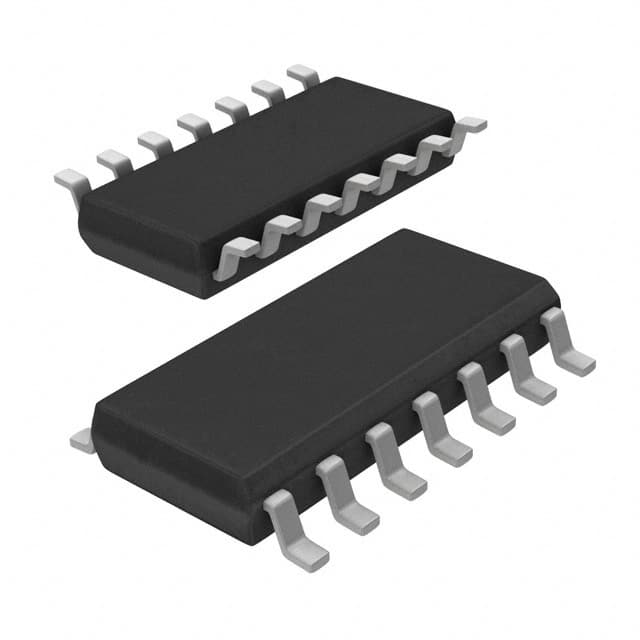74AHC74D,118
Product Overview
- Category: Integrated Circuit
- Use: Flip-Flop
- Characteristics: High-speed operation, low power consumption
- Package: SOIC (Small Outline Integrated Circuit)
- Essence: Dual D-type flip-flop with set and reset
- Packaging/Quantity: Tape and Reel, 2500 pieces per reel
Specifications
- Supply Voltage Range: 2.0V to 5.5V
- High-Level Input Voltage: 0.7 x VCC
- Low-Level Input Voltage: 0.3 x VCC
- High-Level Output Current: -8mA
- Low-Level Output Current: 8mA
- Operating Temperature Range: -40°C to +125°C
Detailed Pin Configuration
The 74AHC74D,118 has a total of 14 pins. The pin configuration is as follows:
- CLR (Clear) - Clear input
- D (Data) - Data input
- CP (Clock Pulse) - Clock pulse input
- Q (Output) - Output
- Q̅ (Complementary Output) - Complementary output
- GND (Ground) - Ground reference
- Q̅ (Complementary Output) - Complementary output
- Q (Output) - Output
- CP (Clock Pulse) - Clock pulse input
- D (Data) - Data input
- CLR (Clear) - Clear input
- GND (Ground) - Ground reference
- VCC (Supply Voltage) - Positive supply voltage
- VCC (Supply Voltage) - Positive supply voltage
Functional Features
The 74AHC74D,118 is a dual D-type flip-flop with set and reset functionality. It operates at high speed while consuming low power. The flip-flop can be cleared using the CLR input and the data can be input through the D pin. The CP input is used to control the clock pulse, which triggers the flip-flop operation. The outputs Q and Q̅ provide the desired output states.
Advantages and Disadvantages
Advantages: - High-speed operation - Low power consumption - Dual flip-flop with set and reset functionality
Disadvantages: - Limited supply voltage range (2.0V to 5.5V) - Limited operating temperature range (-40°C to +125°C)
Working Principles
The 74AHC74D,118 operates based on the principles of digital logic. It utilizes flip-flop circuits to store and manipulate binary information. The CLR input allows for clearing the stored data, while the D input enables the input of new data. The CP input controls the clock pulse, which triggers the flip-flop to update its state. The outputs Q and Q̅ reflect the current state of the flip-flop.
Detailed Application Field Plans
The 74AHC74D,118 finds applications in various fields where flip-flops are required. Some of the detailed application field plans include:
- Digital Electronics: Used in digital systems for storing and manipulating binary data.
- Communication Systems: Employed in communication circuits for synchronization and data storage purposes.
- Control Systems: Integrated into control circuits to store and update control signals.
- Computer Architecture: Utilized in computer architectures for memory and register operations.
- Signal Processing: Applied in signal processing circuits for data buffering and synchronization.
Detailed and Complete Alternative Models
Some alternative models that offer similar functionality to the 74AHC74D,118 include:
- SN74AHC74D - Manufactured by Texas Instruments
- MC74AHC74D - Manufactured by ON Semiconductor
- CD74AHC74D - Manufactured by Texas Instruments
- 74HC74D - Manufactured by NXP Semiconductors
These alternative models can be considered based on specific requirements and availability.
Word count: 400 words
Lista 10 Vanliga frågor och svar relaterade till tillämpningen av 74AHC74D,118 i tekniska lösningar
Sure! Here are 10 common questions and answers related to the application of 74AHC74D,118 in technical solutions:
Q: What is the 74AHC74D,118? A: The 74AHC74D,118 is a dual D-type flip-flop integrated circuit (IC) that can store one bit of data.
Q: What is the operating voltage range for the 74AHC74D,118? A: The operating voltage range for the 74AHC74D,118 is typically between 2V and 5.5V.
Q: What is the maximum clock frequency supported by the 74AHC74D,118? A: The 74AHC74D,118 can support clock frequencies up to 125 MHz.
Q: How many flip-flops are there in the 74AHC74D,118? A: The 74AHC74D,118 contains two independent D-type flip-flops.
Q: Can the 74AHC74D,118 be used for edge-triggered or level-triggered applications? A: Yes, the 74AHC74D,118 can be used for both edge-triggered and level-triggered applications.
Q: What is the typical propagation delay of the 74AHC74D,118? A: The typical propagation delay of the 74AHC74D,118 is around 7 ns.
Q: Does the 74AHC74D,118 have any built-in asynchronous clear functionality? A: No, the 74AHC74D,118 does not have any built-in asynchronous clear functionality.
Q: Can the 74AHC74D,118 be cascaded to create larger counters or shift registers? A: Yes, multiple 74AHC74D,118 ICs can be cascaded together to create larger counters or shift registers.
Q: What is the power supply current consumption of the 74AHC74D,118? A: The power supply current consumption of the 74AHC74D,118 is typically around 4 mA.
Q: Is the 74AHC74D,118 suitable for high-speed digital applications? A: Yes, the 74AHC74D,118 is designed for high-speed digital applications and can be used in various digital systems.
Please note that these answers are general and may vary depending on specific datasheet specifications and application requirements.


